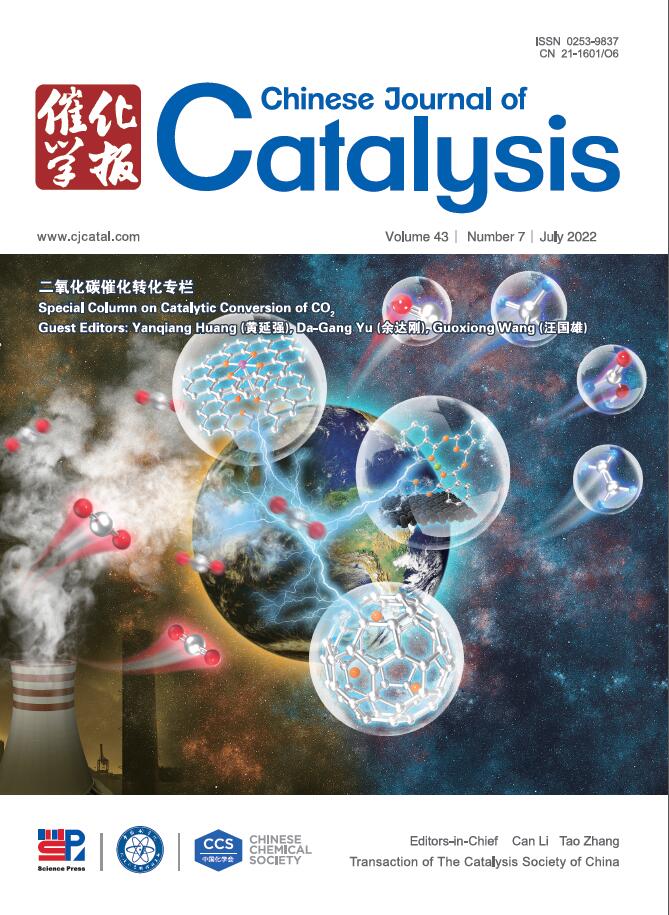机器学习辅助筛选SA-FLP双活性位点催化剂用于甲烷和水制甲醇
IF 15.7
1区 化学
Q1 CHEMISTRY, APPLIED
引用次数: 0
摘要
由于缺乏高效的催化剂,在温和条件下由甲烷和水一步直接生产甲醇(PMMW)在多相催化中具有挑战性。在此,我们通过密度泛函理论(DFT)计算结合机器学习(ML)方法为直接PMMW设计了一系列“单原子”-“受挫刘易斯对”(SA-FLP)双活性位点。结果表明,所设计的9种SA-FLP催化剂均能有效活化CH4和H2O,促进OH*和CH3*偶联生成甲醇。基于dft的微动力学模拟(MKM)结果表明,在Co1-FLP和Pt1-FLP催化剂上生成CH3OH的周转频率(TOFs)分别达到1.01 × 10−3 s-1和8.80 × 10−4 s-1,比实验报道值高出3个数量级。ML结果表明,13个简单特征的梯度增强回归模型可以较好地预测CH3OH生产的tof, RMSE和R2分别为0.009 s-1和1.00。ml预测的MKM结果表明,V1-、Fe1-、Ti1-和Mn1-FLP四种催化剂的CH3OH产率高于大多数相关实验报道的值,表明这四种催化剂也有希望成为PMMW的催化剂。该研究不仅为设计和筛选SA-FLP催化剂提供了一种简单有效的方法,而且为直接PMMW的机理提供了见解。本文章由计算机程序翻译,如有差异,请以英文原文为准。
Machine learning-assisted screening of SA-FLP dual-active-site catalysts for the production of methanol from methane and water
One-step direct production of methanol from methane and water (PMMW) under mild conditions is challenging in heterogeneous catalysis owing to the absence of highly effective catalysts. Herein, we designed a series of “Single-Atom” - “Frustrated Lewis Pair” (SA-FLP) dual active sites for the direct PMMW via density functional theory (DFT) calculations combined with a machine learning (ML) approach. The results indicate that the nine designed SA-FLP catalysts are capable of efficiently activate CH4 and H2O and facilitate the coupling of OH* and CH3* into methanol. The DFT-based microkinetic simulation (MKM) results indicate that CH3OH production on Co1-FLP and Pt1-FLP catalysts can reach the turnover frequencies (TOFs) of 1.01 × 10−3 s–1 and 8.80 × 10−4 s–1, respectively, which exceed the experimentally reported values by three orders of magnitude. ML results unveil that the gradient boosted regression model with 13 simple features could give satisfactory predictions for the TOFs of CH3OH production with RMSE and R2 of 0.009 s–1 and 1.00, respectively. The ML-predicted MKM results indicate that four catalysts including V1-, Fe1-, Ti1-, and Mn1-FLP exhibit higher TOFs of CH3OH production than the value that the most relevant experiments reported, indicating that the four catalysts are also promising catalysts for the PMMW. This study not only develops a simple and efficient approach for design and screening SA-FLP catalysts but also provides mechanistic insights into the direct PMMW.
求助全文
通过发布文献求助,成功后即可免费获取论文全文。
去求助
来源期刊

Chinese Journal of Catalysis
工程技术-工程:化工
CiteScore
25.80
自引率
10.30%
发文量
235
审稿时长
1.2 months
期刊介绍:
The journal covers a broad scope, encompassing new trends in catalysis for applications in energy production, environmental protection, and the preparation of materials, petroleum chemicals, and fine chemicals. It explores the scientific foundation for preparing and activating catalysts of commercial interest, emphasizing representative models.The focus includes spectroscopic methods for structural characterization, especially in situ techniques, as well as new theoretical methods with practical impact in catalysis and catalytic reactions.The journal delves into the relationship between homogeneous and heterogeneous catalysis and includes theoretical studies on the structure and reactivity of catalysts.Additionally, contributions on photocatalysis, biocatalysis, surface science, and catalysis-related chemical kinetics are welcomed.
 求助内容:
求助内容: 应助结果提醒方式:
应助结果提醒方式:


